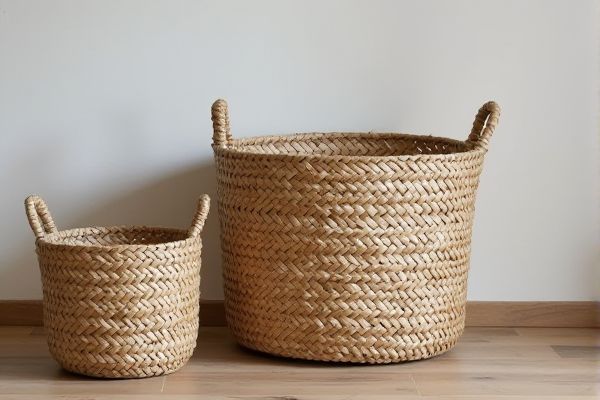
Woven baskets offer a natural, rustic aesthetic and breathability, making them ideal for storing delicate fruits and decorative items, while wire baskets provide durability, visibility, and are perfect for organizing heavier or bulkier goods. Discover the key differences and find out which basket type best suits Your storage needs by reading the full article.
Table of Comparison
| Feature | Woven Basket | Wire Basket |
|---|---|---|
| Material | Natural fibers (rattan, bamboo, wicker) | Metal wires (steel, iron, aluminum) |
| Durability | Moderate; prone to wear and moisture damage | High; resists rust if coated properly |
| Weight | Lightweight | Typically heavier |
| Design | Organic, rustic, aesthetic appeal | Industrial, modern, minimalist look |
| Airflow | Good ventilation | Excellent airflow due to open structure |
| Usage | Decor, storage for lightweight items | Heavy-duty storage, organizing tools or kitchen items |
| Maintenance | Requires careful cleaning; avoid excess moisture | Easy to clean; withstands water and detergents |
| Cost | Generally affordable, varies by craftsmanship | Varies; metal quality impacts price |
Introduction to Woven and Wire Baskets
Woven baskets, crafted from natural materials like rattan, bamboo, or seagrass, provide a rustic aesthetic and breathable storage ideal for household organization and decorative purposes. Wire baskets, typically made from steel or iron with various coatings, offer durability, easy visibility of contents, and enhanced ventilation, making them suitable for industrial, kitchen, or office use. Both basket types balance functionality and style but cater to differing needs based on material strength, design, and intended environment.
Material Composition and Durability
Woven baskets are typically made from natural fibers like rattan, bamboo, or seagrass, offering flexibility and a lightweight structure but are susceptible to moisture damage and wear over time. Wire baskets are constructed from metals such as steel or iron, often coated to prevent rusting, providing superior strength and long-lasting durability even in humid conditions. The choice between woven and wire baskets depends on environmental exposure and the need for structural resilience.
Aesthetic Appeal and Style Differences
Woven baskets offer a natural, rustic charm with their organic textures and earthy tones, making them ideal for cozy, bohemian, or farmhouse-style interiors. Wire baskets provide a sleek, modern aesthetic with their minimalist design and metallic finish, fitting well in industrial or contemporary spaces. The choice between woven and wire baskets significantly impacts the visual ambiance and stylistic coherence of a room.
Practical Uses in Everyday Life
Woven baskets offer breathable storage ideal for fruits, vegetables, and laundry, keeping contents fresh and organized in kitchens or closets. Wire baskets provide durable, open-structure solutions perfect for holding heavy tools, pantry items, or bathroom supplies, allowing easy visibility and ventilation. Both types enhance home organization with distinct material benefits suited to various practical needs.
Storage Capacity and Organization
Woven baskets typically offer flexible storage capacity by adapting to various item shapes and sizes, making them ideal for organizing irregular or soft goods. Wire baskets provide a rigid structure with clear visibility, allowing efficient stacking and quick item identification for better organization. Choosing between woven and wire baskets depends on the need for adaptability versus structural stability in storage solutions.
Maintenance and Cleaning Requirements
Woven baskets require gentle cleaning with a soft brush or cloth to remove dust and can be spot-cleaned with mild soap and water, avoiding excessive moisture to prevent mold or damage. Wire baskets are easier to maintain, as they can be wiped down with a damp cloth or washed with soapy water and dried thoroughly to prevent rust. Both basket types benefit from regular cleaning, but wire baskets demand less careful handling and dry faster, making them more suitable for damp environments.
Environmental Impact and Sustainability
Woven baskets, crafted from natural materials like rattan, bamboo, or seagrass, offer a biodegradable and renewable option that minimizes environmental harm and supports sustainable harvesting practices. Wire baskets, typically made from steel or aluminum, involve energy-intensive mining and manufacturing processes but can be recycled multiple times, extending their lifecycle and reducing waste. Choosing woven baskets can enhance your commitment to eco-friendly living by reducing plastic use and promoting the use of organic, renewable resources.
Cost Comparison and Value for Money
Woven baskets generally offer a lower upfront cost compared to wire baskets, making them an affordable choice for budget-conscious shoppers. Wire baskets tend to have a higher price point but provide greater durability and longevity, potentially saving money over time through reduced replacement frequency. When evaluating value for money, woven baskets excel in aesthetic appeal and eco-friendliness, while wire baskets outperform in strength and multi-purpose functionality.
Adaptability to Different Spaces
Woven baskets provide superior adaptability to different spaces due to their flexible construction and various sizes, fitting seamlessly into irregular corners and shelves. Wire baskets, though durable and sturdy, are typically rigid and better suited to open, accessible areas with consistent dimensions. The choice depends on whether a space requires versatile, snug storage or structured, visible organization.
Choosing the Right Basket for Your Needs
Woven baskets offer natural breathability and aesthetic warmth, making them ideal for storing delicate items, linens, or as decorative accents in your home. Wire baskets provide sturdy, durable support with excellent visibility and airflow, perfect for organizing tools, pantry goods, or heavier items that require ventilation. Assess your storage needs by considering the weight, visibility, and style preferences to select the basket that best suits your space and function.
 homyna.com
homyna.com